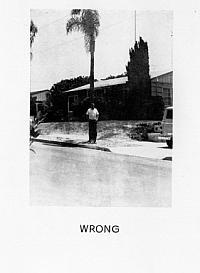Hi,
The next two blogs are articles from Washington EDU about words in art. My new paintings have lyrics painted on the canvases. Magritte was one of the pioneers of words painted on canvas.
Chapter 1: Words in Images

John Baldessari, 1967
The first half of the twentieth century was marked by a sudden explosive emergence of mass-produced images--in the movies, in newspapers, and in magazines, both in main content and in advertising. This unprecedented outpouring was ignored as much as possible by High Art, and to a considerable degree it is still ignored today. In an recent interview with Benjamin Buchloh, the photographer and video artist Martha Rosler answered all of his questions about artists who influenced her and volunteered a name of her own: John Baldessari, who in the 1960s had begun using words with his photographs inside the frame. She describes seeing in 1968 his now well-known picture of himself standing in front of his house and directly in front of a palm tree which thus appears to grow out of his head (Rosler, 1998: 38). Beneath the picture is the word WRONG lettered in large block caps.
That is metadiscourse; I had never seen photographic metadiscourse before. Not only did he use a dumb photo, he made a point of it by sticking a word on it, because of course words were forbidden in photography.
Notice how High Art controls the terms here: photography must not include commercial photography, since nobody apparently forbid words in advertising. "Today, at the level of mass communications," Roland Barthes said in 1964, "it appears that the linguistic message is indeed present in every image: as title, caption, accompanying press article, film dialogue, comic strip balloon" (38). How many times in the twentieth century was the High (Modernist) Art ban on words inside the frame breached by avant-garde artists? Such a move was a leading feature of many programs and movements, though it was made for different reasons and with different effects:
Cubists and Futurists introduced words inside the frame to highlight the visuality of the written and printed word--its Janus-like double facing toward visual shape and abstract content;1
Dadaists glued in bits of newspaper and other lettering into their photomontages and collages in part to claim and remake the look of the illustrated magazine, catalog, newspaper, and other new commercial media.
Pop art continued this struggle, focusing on the popular mixed medium of the cartoon;
Conceptualists almost inverted the ban, filling canvases with words as they reoriented art toward ideas.
Some, like Baldessari, use words reflexively to highlight art as a signifying system;
Others, like René Magritte, Victor Burgin, and Rosler herself, play off visual signification against certain kinds of verbal signification, thus creating a kind of hybrid art form.
There were of course crossovers and connections as well. Tony Godfrey, for example, included a heavily illustrated article in the La Révolution Surréaliste by René Magritte in his collection of Conceptualist works of art. That is probably considerably farther than Magritte would have been willing to go, but it is certainly true that Magritte's experiments at representing representation by words and by images anticipates the linguistic and semiotic concerns of Conceptualism, and (1.1) Magritte's semiotic experiments→ will initiate the discussion in this chapter. 2
We will then work through the (1.2) stable relations→ that words and images can have as words are placed next to or inside the frame of the image. These are the basic types of what Barthes calls "anchorage" of images by text. (The stable relations are titles, labels, placards and legends (where image is primary) to illustrations and instances (where text is primary). These are conventionalized roles for words and images, and there are conventions of congruence between text and image in specific roles. These can be flouted to produce incongruous titles, legends, and so on. Such incongruities highlight the flouted expectations.
(1.3) Appropriations→ are the placing of an image next to a text where one or both of them are lifted out of another context and placed so as to be contexts each for the other (the text next to or inside the frame of the image). This can result in a kind of oscillation between image and text that we will call unstable, but it is also a favorite device of political posters—showing the contradictions—where the text declares one reality and the image shows another. Attention will be devoted here and in the following section to work by artists interested in addressing social and political issues, including Victor Burgin, Martha Rosler, Hans Haacke, and Esther Parada.
(1.4) Unstable relations→ are those in which the text and the image seem to make equal claims to primacy and do not seem to be saying the same thing, thus forcing the viewer to infer some basis for associating them. The distinction I have in mind is like Umberto Eco's open/closed work, but focuses specifically on the point of "how do the words and images go together?"
These artists are photographers and exhibited their work in galleries before there was a Web, though there are now coming to be decent samples of their work online. A more recent generation of artists have chosen the Web and hypertext as their medium and tend to compose in (1.5) Word-Image Chains.→ As Web hypertext has developed in their hands, words and images begin to function interchangeably, with images containing links to pieces of text and texts linking to images. These works typically have multiple screens and paths through image and text, and the effect of following them is to begin to break down any sharp distinction between words and images and to suggest a sort of synthesis. There are many many sites that could be instanced; here we will look at two of the older, "classic" ones (Joseph Squier's "Urban Diary" and Carol Flax's "In the Absence of Memory"), and then at two more recent, JavaScripted ones (Carmin Karasic's "With Liberty and Justice for All" and Liz Miller's "Moles").